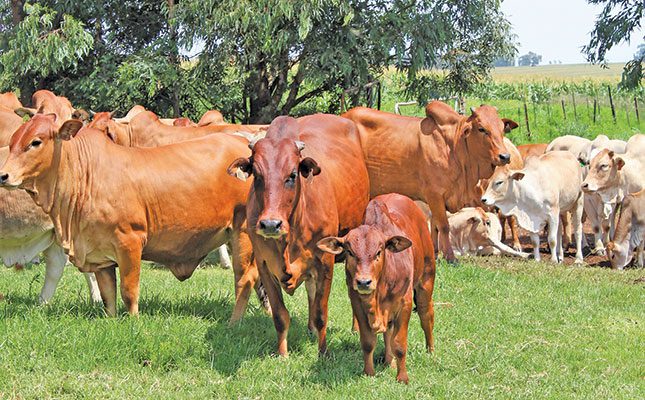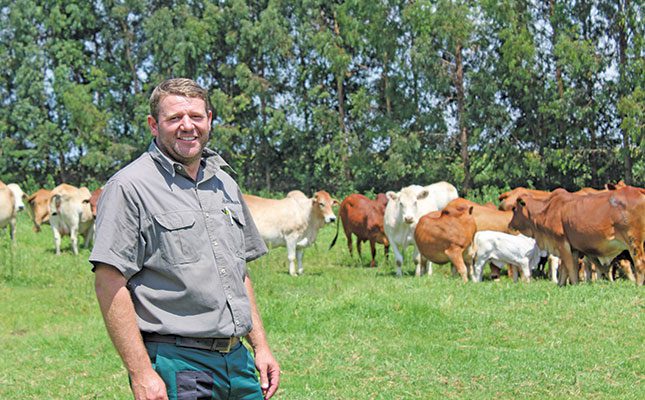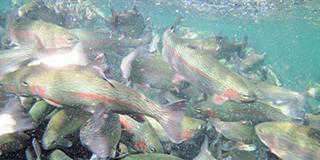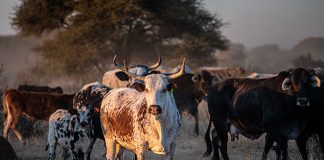
Photo: Lindi Botha
Animals jumping fences is a common pitfall in farming. However, one such incident turned out to be a boon for neighbouring cattle producers in Davel, Mpumalanga, when a Boran bull from renowned stud farmers Jarren and Simeon Hurwitz made his way into Leon van Tonder’s mixed Simbra herd, impregnating a cow.
Van Tonder was so impressed with the calves that were born nine months later, that he not only decided to convert his herd to Borans, but subsequently purchased several bulls from the Hurwitzes.
“The Boran cows conceive quickly and the calves fatten up well on the veld. They are incredibly low-maintenance, as they are hardy and don’t need to be pampered,” says Van Tonder, owner of Remhoogte farm.
While this East African breed has a smaller frame than its European counterparts, Van Tonder has found that he is able to generate a greater profit per hectare, even though the price for the smaller weaners is obviously lower.

“If I had to run a textbook cattle division, feeding and dosing the animals according to industry standards, I would be out of business. To make this division work for me, I had to look at the ideal recipe, and then see how I could adapt it to lower my costs yet still keep the cattle in good shape,” he says.
“The biggest expense on a livestock farm is feed. However, I realised that if I didn’t have to make or provide feed for my cattle, and they could live solely off the natural veld alone and still put on weight, it would be a win for me. A livestock farmer’s greatest asset is an animal that can convert low-quality veld into good-quality protein. And that’s the Boran!”
The early days
Van Tonder grew up on a diversified farm in the Ermelo region of Mpumalanga, travelling past the very farm he now owns on his way to school every day. “There was something about this farm that I noticed back then already, but never in my wildest dreams did I think I’d own it one day,” he says.
Nonetheless, Remhoogte didn’t come into his possession easily. After high school, Van Tonder completed a degree in animal production, then went to the US to work on farms there to gain experience and broaden his world view.
Upon returning to South Africa in 2005, he struggled to find work and was about to pack up everything and return to the US when Remhoogte came onto the market.
“I went to have a look at the farm, but it was so dilapidated. There was hardly a shed, and the farmhouse was uninhabitable. It seemed like it would take a lot of work to get it into shape, and I didn’t have enough money.
“But my father said he would sign surety for a bank loan if I gave him my word that I would do everything in my power to make a success of farming. So I purchased the farm, and used the money I had earned in the US to buy a few cattle,” he explains.
Van Tonder borrowed his father’s implements to plant his first maize crop. But a hailstorm hit just as the plants were beginning to emerge, and then there was no rainfall for the rest of the season. What followed were two of the most difficult years of Van Tonder’s life as he struggled to make ends meet after his first crop failed, and was forced to sell half of his cattle.
With the next planting season around the corner, however, he swallowed his pride and asked another farmer in the area for some soya bean seed, only paying for it after the harvest.
With this crop, he had a stroke of luck that set him up for success: not only did he achieve a record harvest, but the soya bean seed planted in KwaZulu-Natal, the same cultivar that Van Tonder planted, was knocked out by hail, so he was offered double the market price for his crop.
He says that while soya bean got him to where he is today, cattle have always been a useful “piggy bank” when times are tough.
Traits that work
Van Tonder has built up his commercial herd to 1 000 breeding cows, and is working towards a pure-bred Boran herd, moving away from the Simbra crosses. “The Borans have specific characteristics that work for my farming system. I am first and foremost a crop farmer, so when it is planting and harvesting season, I don’t have time to run after cattle, chase them into camps, and help the mothers calve,” he explains.
“The Borans are hardy; they’re made for Africa. They are fertile, have good mothering abilities, calve with ease due to their small calves, and are inclined to eat the hard grasses that many other breeds of cattle wouldn’t. Their short hair and thick skin make them more resistant to diseases, so medicine costs are lower.
“They also do well is any crossbreeding programme, as the Boran’s genes are far removed from those of most other breeds, so you really get hybrid power.
“In addition, the longer you breed Boran genes into your herd, the more prominent their characteristics become and the more you benefit from their traits,” adds Van Tonder.
He notes that the cattle have a strong family bond, and huddle together to protect the calves: “They are tame enough to walk among, but don’t try to get between one of them and the rest of the herd, as they will charge you. They are a lively breed, but this makes them far more difficult to steal.”
Van Tonder says calculating income from cattle goes beyond just the price paid per weaner.
While the smaller Borans fetch lower prices, he achieves more weaners per cow, with each one averaging 13 weaners by the time they are 15 years old. And since his expenses are minimal for the extensively grazed cattle, they are proving quite profitable.
In summer, the herd feeds on the mixed sour- and sweetveld, and receives a phosphate lick. The first frost arrives in May, decreasing the value of the already withering veld, so the animals are given a production lick.
From June onwards, they feed on high-energy maize and soya bean crop residues, which sees them through the cold winter. This also reduces the need for costly licks. “I can feed 100 cattle for a month on 100ha of crop residue. If I had to buy in that feed or silage, it would cost me a fortune,” says Van Tonder.
August and September are the two most difficult months on the farm, as the rain has not yet arrived, and palatable, high-quality veld grass is scarce. Thus, a production lick is added to the cattle’s diet.
The rain comes in October, and it is then that the animals revert to the phosphate lick and the veld.
Van Tonder’s stocking rate varies according to the quality of the veld, but he says that because of the Boran’s smaller frame, he averages 3ha/MLU, as opposed to the 4ha/MLU for larger breeds.
Longer breeding cycle
The extensive nature of Van Tonder’s farm means that the cattle’s breeding season runs for six months, which results in a conception rate of about 90%.
Bulls and cows are placed together in camps at a ratio of one bull for every 35 cows. Van Tonder also started artificial insemination this year, using semen from three of his own bulls, whose genes he wants to strengthen in the herd. In this way, he is also able to breed his own bulls, instead of having to buy new ones.
“Using bulls born to my cows benefits me in three ways: it’s cheaper than having to buy them in; they are already adapted to my farm; and since bulls are ready to mate at two years of age, I can use mine earlier than their bought-in counterparts, which are only sold at around four years old.”
Earlier calving season
Although spring is an ideal season in which to calve, Van Tonder aims to bring his calving season forward to July. The cows will then have enough time to calve, wean by February, conceive again and be in a good condition as a result of the lush veld by the time winter arrives.
Another reason for calving in July is that weaner prices are generally higher in February.
The average intercalving period (ICP) on Remhoogte is 380 days, and cows are kept until their fertility starts to drop. “If [a cow’s] ICP starts declining towards 500 days, she is culled from the herd. She must also produce a healthy weaner; if the weaner is below-average, it is an indication of weaker genes, so the cow is culled. Cows that struggle to feed because of worn teeth are also culled.”
The average weaning weight is 220kg. Van Tonder selects the top 90% of the females to add to his herd, and sells the rest for slaughter.
He takes the maize price into consideration when deciding whether to background the bull calves first or send them directly to the feedlot.
“In a year where the maize price is high, we background the bull calves on the farm because it’s cheaper for us to do it with our own maize than to send them to the feedlot and use their maize.
“However, when the maize price is low, the weaner price is usually higher, so then we send them straight to the feedlot.”
Van Tonder has used every stroke of luck to his advantage and, through careful consideration, has made choices that have stood him in good stead.
The Boran’s traits have had a significant positive effect on his success, and he says he’ll never switch to another breed. “The Boran works in every scenario: if someone from the city wants to farm cattle but knows nothing about the animals, I’d suggest they start with the Boran.
“Borans will even add value for a large-scale farmer, because the management of these animals is less complicated, so dealing with 2 000 head is that much easier.
“For me, it means that I can expand my herd without increasing my workload,” he explains.
Email Leon van Tonder at [email protected].













